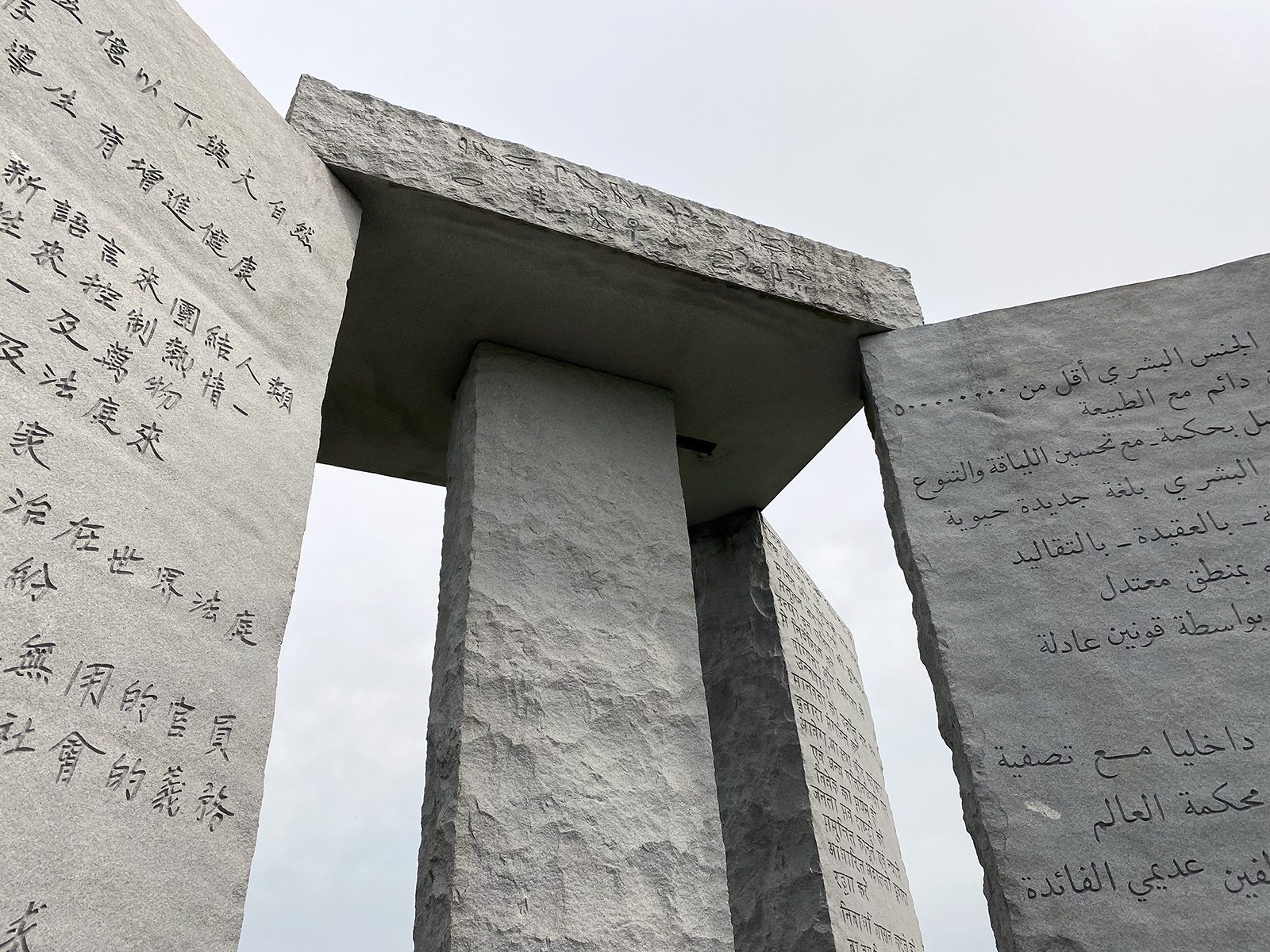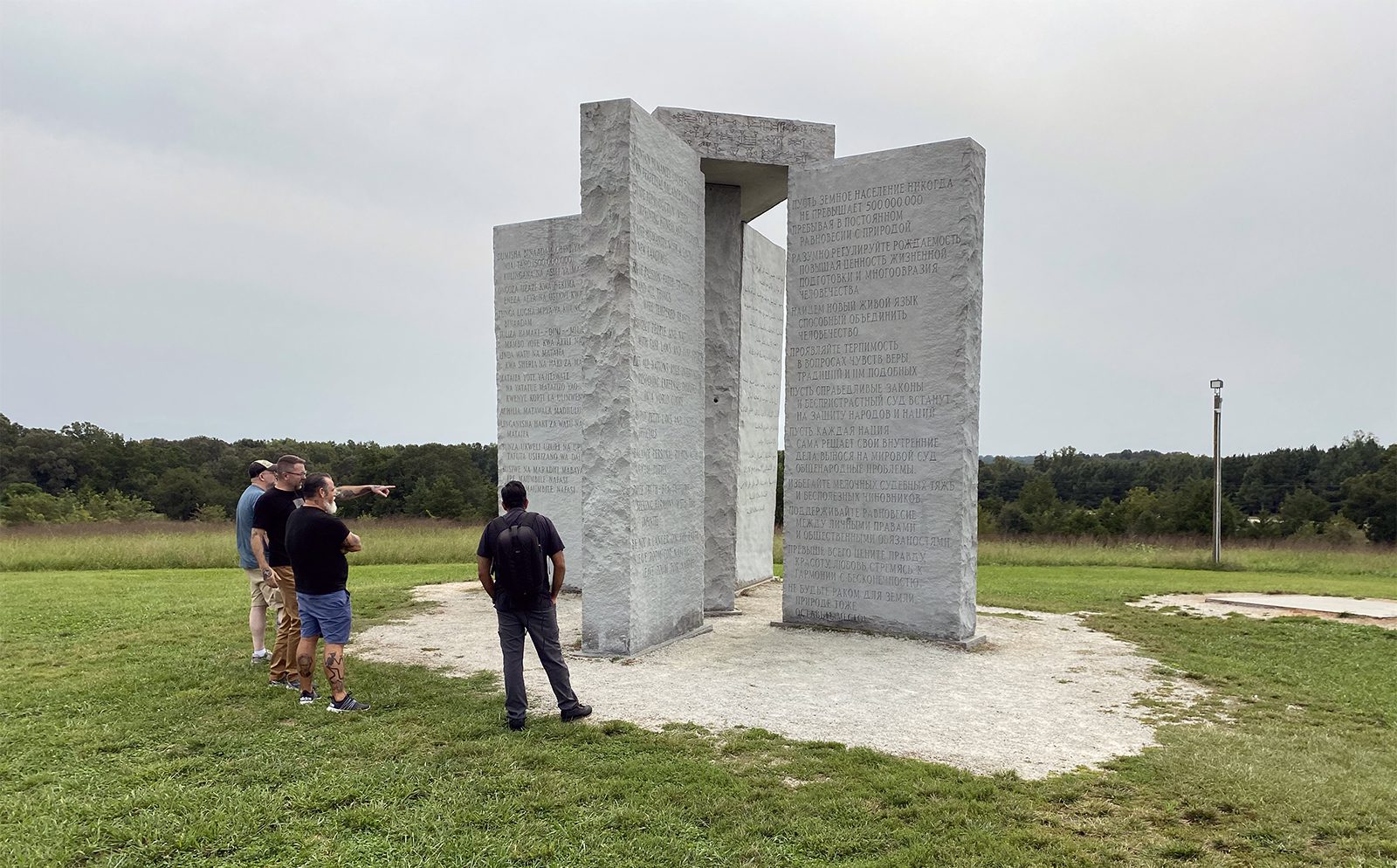Georgia Guidestones, long treasured and feared, demolished after attack
ATLANTA (RNS) — After 42 years, the mysterious Georgia Guidestones, often called America’s Stonehenge, are no longer casting a shadow in rural Elbert County, Georgia. Early Tuesday (July 5), one of the six slabs of granite making up a primitive-looking monument was destroyed by what the Georgia Bureau of Investigation believes was an explosive.
The remaining stones were removed Wednesday after officials determined they were unstable.
The Guidestones stood for more than 40 years among fields seven miles outside of the small town of Elberton, a 40-minute drive from Athens, Georgia. For decades they’ve been a source of inspiration, fear and curiosity. Hand-carved words across the nearly 20-foot-tall slabs brought discomfort and debate.
RELATED: Instagram ‘smash and grab’ impostors peddle fake psychic and tarot readings
In 1979, John Fendley, then-president of the Elberton Granite Finishing Co., was asked to create the monument by someone known by the pseudonym Robert Christian (later R.C. Christian), who claimed to represent a group of concerned Americans. Today, some believe that Christian was Dr. Herbert H. Kersten of Fort Dodge, Iowa, who died in 2005. However, this is still mostly speculation.
At first, Fendley thought Christian was crazy and the request was a hoax, but neither proved to be the case. With the help of local banker Wyatt C. Martin, Christian secured funds for his project and construction began.
The stone structure was revealed to the public on the spring equinox in 1980. Together the 951 cubic feet of granite weighed 237,746 pounds. The center slab was surrounded by four standing stones of similar height, and the entire structure was capped by a sixth stone 6 ½ feet wide, 10 feet long and 7 inches thick.

The Georgia Guidestones monument near Elberton, Georgia, in September 2020. Photo by Heather Greene
The impressive size of the structure was only part of its allure. Carved on each of the four outer slabs were 10 precepts — a message to humanity — repeated in English, Spanish, Swahili, Hindi, Mandarin Chinese, Hebrew, Russian and Arabic. Translators from the United Nations assisted Christian with the translations.
Inscribed in the capstone was the phrase “Let these be guidestones to an Age of Reason,” written in ancient Greek, Egyptian hieroglyphs, Sanskrit and Babylonian cuneiform.
The center slab and capstone also acted as an astrological calendar, with carefully cut holes for observance of the moon, sun and North Star. Astronomers from the University of Georgia assisted in refining this part of the project.
While Christian’s identity is still a mystery, his purpose is not.
Created during the Cold War, when a nuclear holocaust felt like a real threat, the stones were intended to be a beacon for those that survive. According to local historian Raymond Wiley, Christian wanted to prevent humanity from returning to the “bleak place” it was in. The precepts are a prescription for a peaceful world. Wiley is co-author of the book “The Georgia Guidestones: America’s Most Mysterious Monument.”
Wiley told Religion News Service, “It is amazing how our society has forgotten the threat of nuclear war.” This context, he said, is lost on today’s visitors, but was not in 1980.
Despite Christian’s declaration of purpose, conspiracy theories arose almost immediately. “People bring their own beliefs with them” when viewing the stones, said Wiley.
Nearly immediately, local pastors decried the stones as satanic. “We don’t think Mr. Christian is a Christian,” said the Rev. James Traffensted of the Elberton Church of God after the 1980 ceremony. “Look what it says about the unity of the world. That’s where the Antichrist will unite the governments of the world.”
In his 1986 self-published book “Common Sense Renewed,” Christian called himself “a follower of Jesus,” expressing a broad view of spirituality and religion. “No religion has a monopoly on truth,” he wrote.

People visit the Georgia Guidestones monument near Elberton, Georgia, in September 2020. Photo by Heather Greene
The satanic origin theory never fully retreated, and it recently gained steam when former Republican gubernatorial candidate Kandiss Taylor made demolishing the stones part of her 2022 campaign. On May 2, she tweeted: “Elect me Governor of Georgia, and I will bring the Satanic Regime to its knees— and DEMOLISH the Georgia Guidestones.”
After the stones were destroyed Wednesday, she tweeted, “God is God all by Himself. He can do ANYTHING He wants to do. That includes striking down Satanic Guidestones.”
Taylor has since stated that she does not support vandalism and has disavowed a connection to any such destruction.
The bombing was not the first time the monument was targeted. In 2008, a masked man calling himself an “American patriot” defaced the monument as a warning to the “global elite.” He tied the Guidestones to a coming new world order, a conspiracy theory perpetuated by QAnon followers and expressed by personalities such as InfoWars founder Alex Jones.
Others of various political or religious affiliations criticized the stones as a call for mass depopulation or support for eugenics. Theories abound.
Feeding those beliefs is the rumor that Christian was a Rosicrucian and part of a secret historical order of esoteric philosophers and thinkers. The initials “R.C.” is, for some, a clear indicator, as well as the stones’ precepts and its astronomical usage.
Some onlookers were attracted by the implied occult connections. A local group of Wiccans performed periodic rituals at the site not long after the stones were erected. Lady Galadrial and Lord Athanor, founders of Grove of the Unicorn, would regularly visit the stones with others, believing the land had spiritual significance. Both Galadrial and Athanor have since died.
As practitioners of an earth-based religion, they found the precepts’ call to respect nature of particular interest. “I certainly see this as some sort of center for occult activity,” Galadrial said at the time.
Other occultists and those who study the world’s spiritual centers agreed. According to Wiley, a Christian preacher even once offered to donate money to beautify the place, claiming the site was sacred.
When the stones were demolished, witch and author Vincent Higginbotham tweeted, “I just cannot. I love this place. What is happening?” Higginbotham’s family is from Elberton. He has “wholesome family memories” of visiting the site, standing together “marveling at the mysterious background, the message and the design,” he told RNS.
Wiley believes that the remaining pieces will end up in some museum locally. “They were a showpiece of the area, made by proud masons,” he said. Some in Elbert County, often called the granite capital of the world, regarded the guidestones as a symbol of the industry’s pride. The Elberton Granite Association maintained the stones until Wednesday.
RELATED: What is Wicca? An expert on modern witchcraft explains.
After hearing the news and seeing video of the bombing, Wiley, who calls himself a Southerner and an “exvangelical,” said he was not surprised at the stones’ fate, citing the gross amount of superstition surrounding the stones for all these years. Wiley is fearful that this is a “harbinger of things to come.”
“The stones would probably have survived a nuclear war” as Christian intended, Wiley said, “but they could not survive Southern culture.”


